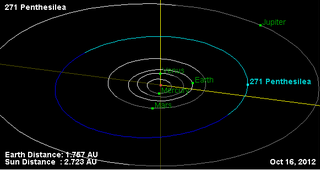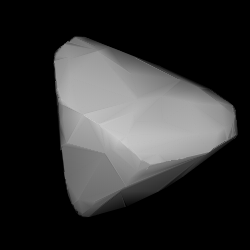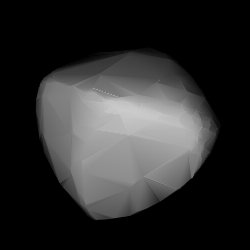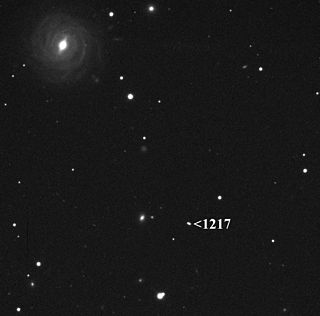2003 YN107 is a tiny asteroid, classified as a near-Earth object of the Aten group moving in a 1:1 mean-motion resonance with Earth. Because of that, it is in a co-orbital configuration relative to Earth.

Dejanira is a main belt asteroid that was discovered by Alphonse Borrelly on 1 December 1875, and named after the warlike princess Deianira in Greek mythology. The Dejanira family of asteroids is named after it.

Ophelia is a large, dark Themistian asteroid that was discovered by French astronomer Alphonse Borrelly on 13 January 1877, and named after Ophelia in Shakespeare's Hamlet.

Eucharis is a large, slowly rotating main-belt asteroid that was discovered by French astronomer Pablo Cottenot on February 2, 1878, from Marseille Observatory. It was his only asteroid discovery. This object was named after Eucharis, a nymph from the 17th-century novel Les Aventures de Télémaque.
Oppavia is a sizeable Main belt asteroid. It was discovered by Austrian astronomer Johann Palisa on 31 March 1886 in Vienna and was named after Opava, a town in the Czech Republic, then part of Austria-Hungary, where Palisa was born. It is orbiting the Sun at a distance of 2.75 AU with an orbital eccentricity (ovalness) of 0.077 and a period of 4.55 yr. The orbital plane is inclined by an angle of 9.47° to the plane of the ecliptic.

Penthesilea is a mid-sized main belt asteroid that was discovered by Viktor Knorre on 13 October 1887 in Berlin. It was his last asteroid discovery. The asteroid was named after Penthesilea, the mythical Greek queen of the Amazons.

Florentina is an S-type (stony) main belt asteroid with a diameter of 28 km. It was discovered by Johann Palisa on 15 October 1891 in Vienna. He named the asteroid for his daughter, Florentine. Between 1874 and 1923, Palisa discovered a total of 122 asteroids.

Ella is a typical Main belt asteroid. It was discovered by Max Wolf and A. Schwassmann on 11 September 1898 in Heidelberg. This is the eponymous member of a proposed asteroid family with at least 15 members.
Centesima is a 50 km Main-belt asteroid orbiting the Sun. It is one of the core members of the Eos family of asteroids. Relatively little is known about this tiny asteroid. It is not known to possess any natural satellites, so its mass is unknown. However, its brief rotation period of just over 5 hours implies that the body must be exceptionally dense, for its gravity is able counteract the centrifugal force. It was discovered 24 August 1903 by late-nineteenth- and early-twentieth-century astronomer Max Wolf. It was his 100th asteroid discovery, hence the name, which in Latin, means "hundredth".
650 Amalasuntha is a minor planet orbiting the Sun that was discovered by German astronomer August Kopff on October 4, 1907, at Heidelberg. It was named after Amalasuntha, the queen of the Ostrogoths from 526 to 534 AD. The name may have been inspired by the asteroid's provisional designation 1907 AM.
652 Jubilatrix is a minor planet, specifically an asteroid orbiting in the asteroid belt. It was discovered on 4 November 1907 by Austrian astronomer Johann Palisa, and was named in honor of the 60th anniversary of the reign of Franz Joseph. The asteroid is orbiting at a distance of 2.55 AU with a period of 4.08 yr and an eccentricity of 0.127. It is a member of the Maria dynamic family. Photometric observations provide a rotation period of 2.6627±0.0001 h with a brightness variation of 0.27±0.03 in magnitude.

748 Simeïsa is a very large Hilda asteroid from the outermost regions of the asteroid belt, approximately 104 kilometers in diameter. It was discovered on 14 March 1913, by Russian astronomer Grigory Neujmin at the Simeiz Observatory on the Crimean peninsula. The dark P-type asteroid has a rotation period of 11.9 hours and a shape that is reminiscent of a tetrahedron. It was the first asteroid discovery made in Russia and named after the discovering observatory and its nearby Crimean town, Simeiz.
871 Amneris is a minor planet orbiting the Sun. It is the namesake of the Amneris family, a subgroup of the Flora family of Main Belt asteroids.
912 Maritima is an asteroid in the asteroid belt. Based on lightcurve studies observing Maritima over a three-month period, Maritima has a rotation period of 1332 hours. Analysis reveals a possible synodic period of 1332±5 h. Superslow rotators, those with periods longer than a few days, are generally small asteroids. The current paradigm is that slowing of an asteroid's spin rate is the result of YORP radiation pressure, which acts on the target as the inverse square of its size and the inverse of its semi-major axis. The rotation period is less than conclusive.
939 Isberga is a background asteroid from the inner asteroid belt near the region of the Flora family. It was discovered from Heidelberg on 4 October 1920 by Karl Wilhelm Reinmuth. As was his common practice, Reinmuth gave the asteroid a feminine name without reference to any specific person.

3174 Alcock is a carbonaceous Themistian asteroid from the outer region of the asteroid belt. It was discovered by American astronomer Edward Bowell at Lowell's U.S. Anderson Mesa Station in Flagstaff, Arizona, on 26 October 1984. The likely C-type asteroid has a rotation period of 7.1 hours and measures approximately 19 kilometers in diameter. It was named after British amateur astronomer George Alcock (1912–2000).

1220 Crocus, provisionally designated 1932 CU, is a stony Eoan asteroid and slow rotator from the outer regions of the asteroid belt, approximately 17 kilometers in diameter. It was discovered on 11 February 1932, by German astronomer Karl Reinmuth at Heidelberg Observatory in southwest Germany.

1217 Maximiliana, provisional designation 1932 EC, is a background asteroid from the inner regions of the asteroid belt, approximately 17 kilometers (11 mi) in diameter. It was discovered on 13 March 1932, by Belgian astronomer Eugène Delporte at the Royal Observatory of Belgium in Uccle. The asteroid was named in memory of Max Wolf, a German astronomer and discoverer of asteroids himself, who independently discovered this asteroid.
2905 Plaskett, provisional designation 1982 BZ2, is a stony Gefionian asteroid from the central regions of the asteroid belt, approximately 10 kilometers in diameter. It was discovered on 24 January 1982, by American astronomer Edward Bowell at the Anderson Mesa Station near Flagstaff, Arizona. The asteroid was named after Canadian astronomers John Stanley Plaskett and Harry Hemley Plaskett.
1229 Tilia is a dark Themistian asteroid from the outermost regions of the asteroid belt, approximately 28 kilometers in diameter. It was discovered on 9 October 1931, by astronomer Karl Reinmuth at the Heidelberg Observatory in southwest Germany, and given the provisional designation 1931 TP1. The asteroid was named for the genus of trees, Tilia (lime tree, linden, basswood).










